Google receives over 1.2 trillion searches every year.
It’s no surprise why content marketers are spending so much cash, effort and energy into targeting them – and bringing ideal customers to their website via search.
But in order to target them, you need to focus on one thing: keywords.
The words, phrases and sentences that your audience is searching for are critical. By finding the right keywords, understanding them, and using them on your website, you could hit the jackpot: A boost in organic traffic – and content marketing ROI – as a result. Sounds like the dream, right?
In this guide, we’ll explain everything you need to know about SEO keyword research from a content marketer’s point of view, from finding “good” keywords to using them on your website.
The Different Types of Keywords
The keywords you’re choosing are just as important as the words you’re selecting. Pick the wrong keyword – one that fails to drive the right traffic to your content – and you could drop to the bottom of the SERPs faster than you can say the word “Google”.
Pick a good keyword that attracts the right audience and there’s no reason why your content marketing strategy can't be the largest driver of new customers for your business. Share on XSo, let’s iron out the basics and get to grips with the different types of keywords that you can target.
Dive Deeper: How to Build a High-Performance Content Marketing Strategy
Competitive Keywords
It can be difficult to make yourself heard in Google’s SERPs. Only ten businesses are rewarded with an organic first-page result. But combine that with the ~3 paid ads and featured snippet boxes that often crop up, and you’ll quickly understand why 91% of content gets zero organic search traffic.
But that doesn’t mean it’s impossible to reach the top spots. It does mean, however, that you’ll need to think about the competitiveness of each keyword before you go full force with targeting it.
The competition score of a keyword tells you how difficult it will be to rank in Google for a specific keyword. It’s based on several factors, including:
- Which websites are targeting it
- The Domain Authority (DA) of those websites
- The number of links that each page targeting that phrase has
- The average bid price for the keyword in paid search
So, for each keyword you find, plug it into Ubersuggest and take note of the score:

A competitive keyword (with a score of 89) might be trickier to target. Smaller websites without established credibility or current keyword rankings should steer clear of them. Only the most powerful websites with existing SEO power are likely to rank for that keyword.
A keyword with a lower competition score of 18, however, is a fantastic option for smaller websites. The lower score indicates that not many authority-rich websites are targeting the phrase, meaning that it’s easier to rank for.
Dive Deeper: How to Use Google Keyword Planner for Content Creation
Brand vs. SEO Keywords
Keywords typically fall under two umbrella categories:
- Traditional SEO keywords: The phrases you’ve chosen to target on your website based on their search volume and competition alone. Examples include “keyword research tips” or “how to do SEO”.
- Branded keywords: Search queries that reference your company’s name or other branded elements specifically, such as “Single Grain”.
The bad news? There’s no “one size fits all” solution that will provide the ideal balance of branded and traditional keywords for all websites.
However, you can tweak your targeting strategy depending on your business:
New Businesses
Suppose that you’ve recently launched a new startup. There isn’t any existing search volume for your company’s branded keywords because your brand name is new.
In this case, your ideal SEO scenario involves two major tactics:
- Targeting traditional SEO keywords
- Building up brand recognition using other types of marketing
Since targeting branded keywords within your SEO efforts won’t make sense at this point, focus your energies instead on targeting traditional SEO keywords. For example: If you’ve launched a startup in the personal finance space, you might target the phrases “personal finance tool” or “online savings tool” (depending on your startup’s business objectives).
By targeting the phrases that you anticipate your users will be entering into the search engines with both your on-site and off-site SEO activities, you’ll begin to build up the momentum needed in order to build familiarity with your brand.
At the same time, though, you’ll want to put some effort into carrying out branding activities on other web properties to begin generating the branded search traffic needed to win in the SERPs over time.
There are dozens of ways to do this, but here a few places to start:
- Writing and submitting press releases detailing your startup’s launch and benefits
- Setting up social media profiles and optimizing them with branded imagery
- Claiming any local business profiles (as found on Google+, Yelp and similar sites) that are applicable to your business
- Releasing content marketing pieces that capture your audience’s attention while promoting your brand
Businesses with Brand Recognition
Single Grain has a range of clients, and we’re ranking well for keywords in organic search (like this post on “SEO techniques”:
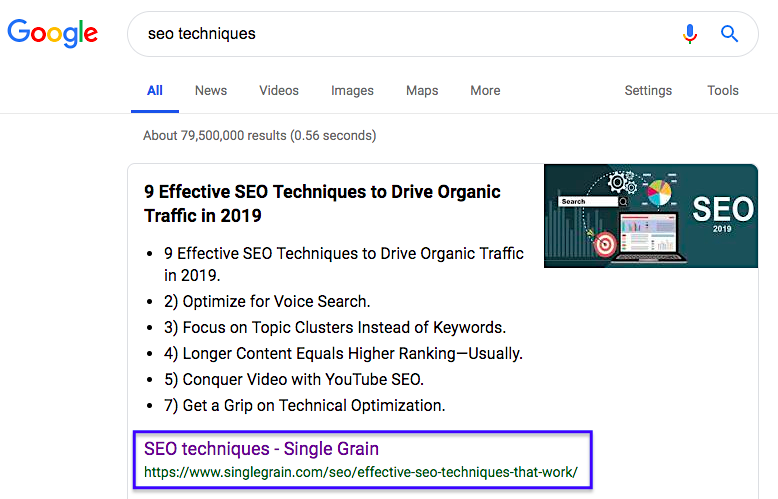
As consumers become used to seeing your brand name mentioned on the web properties they frequent, they’ll be more likely to use your brand name in association with the queries that they enter into the search engines.
That’s why businesses with some brand recognition should begin targeting branded keywords more heavily throughout their website.
So, instead of relying solely on traditional SEO keywords to drive organic traffic, we’re optimizing our content for our brand name to boost recognition. And really, no matter what size your business is, the power of branding is something you need to be aware of.
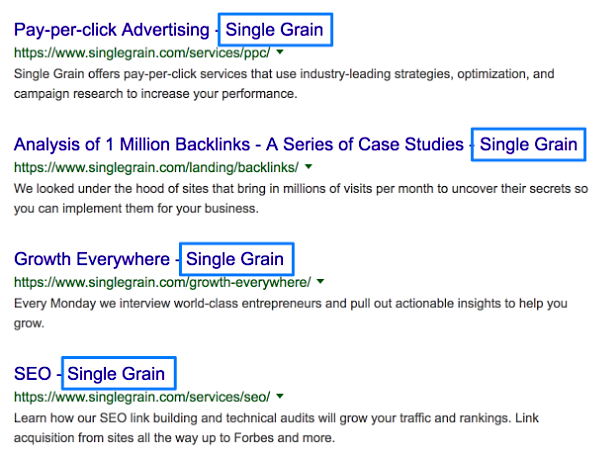
Integrating branded keywords into your SEO approach will help your site to build recognition with both visitors and the search engines – recognition which is likely to play a larger and larger role in the way your site’s authority is measured by Google in the future.
Learn More:
- Should a Blog Post Focus on One Keyword or Multiple Keywords for SEO?
- Quality Over Quantity: The Balance of Keyword USAge
- The Best Way to Track Your Keyword Rankings: An SEO Expert’s Strategy
A Step-by-Step Guide to Finding Keywords
Chances are, these questions are whizzing around in your head:
- What are people who are interested in my niche looking for?
- What questions do they have?
- What do they like?
- What do they read?
- What type of content are they searching for?
Keywords offer a lot of insight into these factors, giving you a glimpse into the common searches that your audience is performing. The goal is to see what they want and then provide it.
Here’s a step-by-step guide you can use to find keywords:
1) Start with What You Know
What are the core terms that your business focuses on?
Sit down and make a list of all the terms your site is about, but don’t get too specific. At this point, you’re simply working on the list of your core terms – i.e. those common-knowledge terms for which you are building a business.
For a SaaS tool that helps small businesses break down their expenses, that might be:
- Small business accounting
- Expenses
- Tax returns
- Receipts
- Invoicing
A word of warning here: If you try to come up with hundreds of terms, you will only become overwhelmed. Don’t worry, there will be plenty of time to expand your list as you progress!
But more importantly, remember that these core terms won’t give a content marketer actionable content ideas because they’re too generic. You’ll be able to discover content topics to develop further by expanding your core list.
Start by modifying your terms. These are add-on words to the core (or primary) keyword that help give you an edge. So going back to the accounting software example, you could use something like “filing receipts” or “organizing tax return”. (The bold indicates the core; the italics the modifier.)
You’re able to use these longer variations on your website and have an easier time ranking for them because the modifier makes them less competitive.
2) Go Straight to the Source with Google Suggest
Remember what we said about highly competitive keywords?
Trying to compete in the natural search rankings for a general term like “SaaS” is going to be an uphill battle, requiring substantial investment of time (or cash) in order to see results. So instead, look for the low-hanging fruit of sub-niches using Google’s Related Searches feature.
Simply head over to Google and type a general keyword or an evergreen keyword phrase into the search bar without pressing enter. You’ll find a list of recommendations based on the queries that people are searching for:
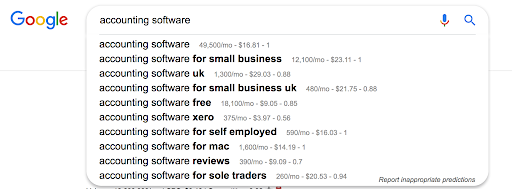
If you’ve got the Keyword Keg Chrome extension installed, you’ll be able to view the search volume and competition score for each phrase (like the screenshot above).
Simply whittle down the suggestions into a list of keywords that:
- Don’t have too high of a competition score
- Have a medium-low search volume
Keywords fitting that criteria means they’re easier for new sites to rank for, without much existing SEO power.
3) Use Google Trends to Discover More Core Terms
Google Trends is a fantastic resource that shows the popularity of a keyword. You can use it to check whether the phrases you’re using are increasing or decreasing in usage, allowing you to write content around trending topics. But you might be surprised to learn that it’s also a great resource for finding related keywords.
Type your core topic into the search bar and scroll to the Related Queries report. This shows which queries users searching for your term also searched for:
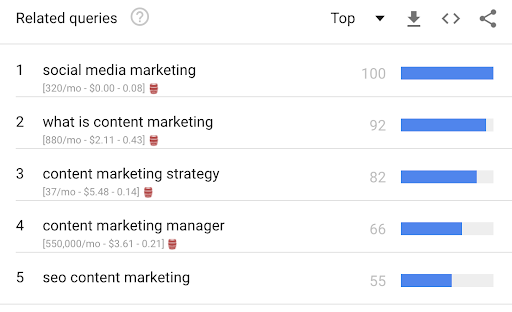
Notice the “Top” button towards the right-hand side of the screenshot? Click this button and select one of these options:
- Top: These are the most popular search queries and, in many cases, the core terms you’ll be breaking down into more specific article ideas.
- Rising: These are queries with the biggest recent increase in search frequency, along with the percentage increase in search.
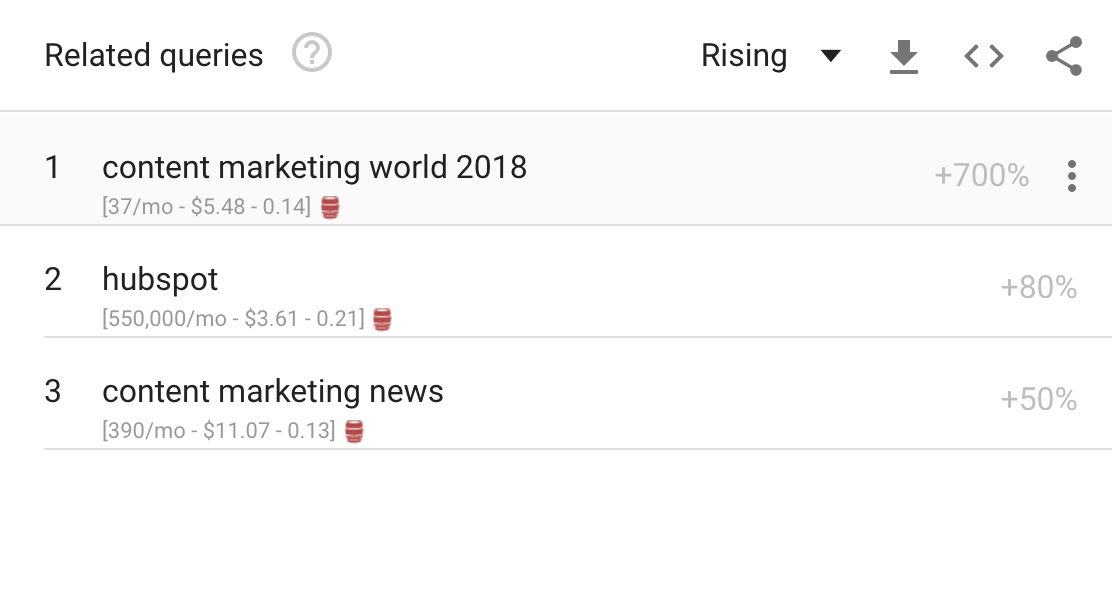
4) See What Your Competitors Are Targeting
You want to save time when doing keyword research – I get it. Why not take a shortcut and see which keywords your competitors are already targeting and ranking for?
This tactic is fantastic for two reasons:
- You can find long-tail phrases that other keyword research tools might not have picked up on, but still drive qualified traffic.
- Your competitors are not only researching keywords, but are molding their strategy to fit them. You can see the end result, which can be awesome for figuring out what it is that your mutual audience is responding to (or not responding to) without risking it first-hand.
Let’s say, for example, that Single Grain was your competitor. Simply type your URL into SpyFu and find a list of keywords we’re ranking for, alongside our ranking positions, search volume, and estimated clicks per month:
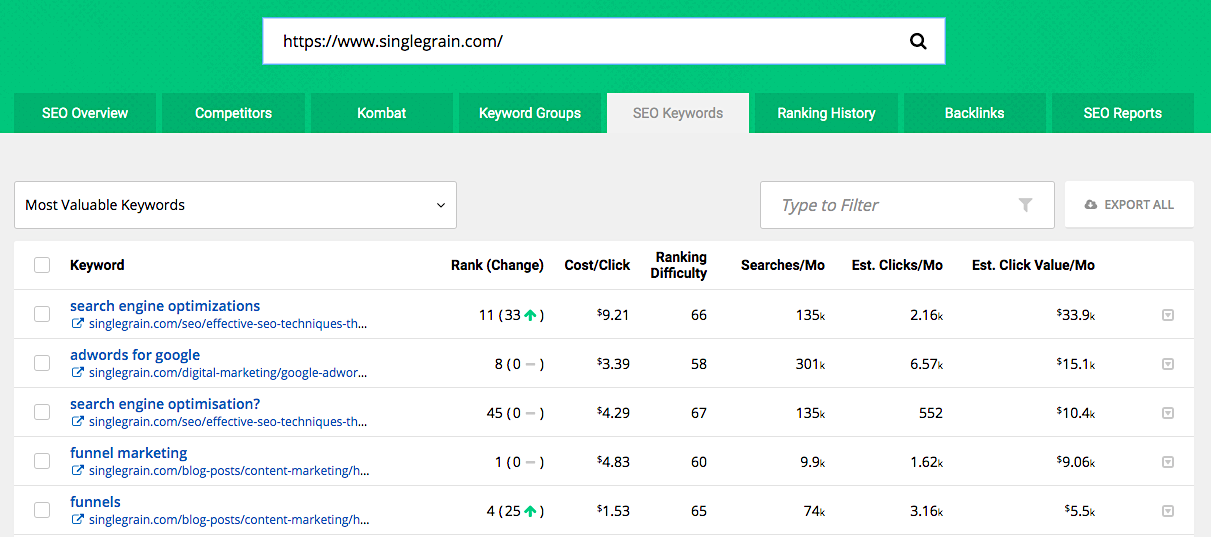
There’s no way around it: This data is a goldmine for content marketers.
But the beauty of this tool is that it provides a page-level report too, not just domain-level like most of its alternatives. I can research any competitor’s article and drill down to how it is performing in search…
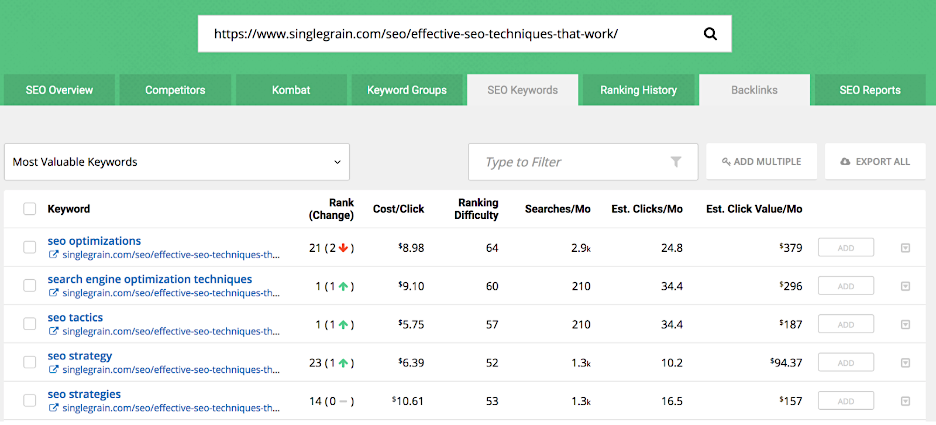
…Giving me a whole host of long-tail keywords to draw inspiration from, and create content around.
A word of warning: Don’t directly copy everything you find here. Competitors should give you inspiration, not the basis for a copy and paste job. Try to put your own spin on everything; it’s the best way to create content that ranks without regurgitating the same, tired content. Neither Google nor your audience will be impressed.
5) Research the Question-Type Queries
Question-type queries are often straightforward content ideas. Why? The answer is simple:
Knowing which questions people are asking in your niche gives you valuable insight into their struggles.
You can then mould your content around your queries to make sure you’re driving the right kind of search traffic to your website – and helping them navigate through your marketing funnel.
Here are three tools you can use to find question-based keywords:
- AnswerThePublic is a free keyword research tool that crawls Google’s search suggestions, finds questions among them, and visualizes the results. Take a look at the results for “content marketing” (this data will easily inspire tons of content ideas!):

- Serpstat Questions, like AnswerThePublic, uses Google’s Suggest database to identify question-type queries. This keyword research tool will also analyze the results, and create a list of related questions you could use to form your editorial calendar:
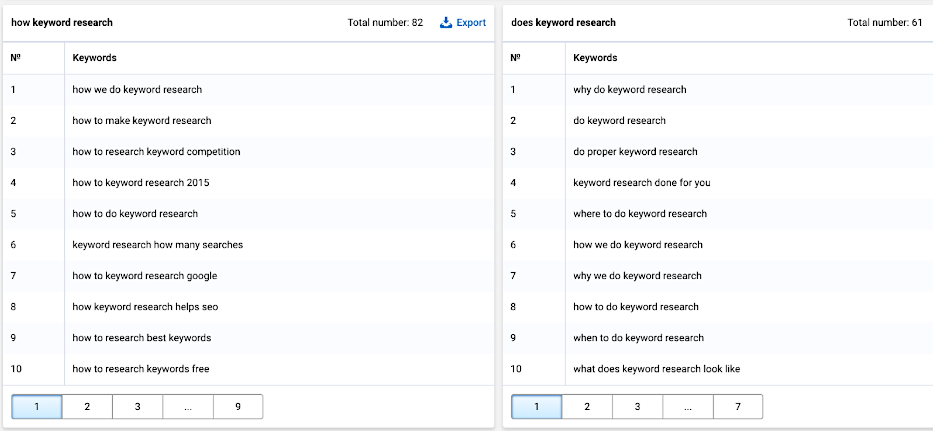
- Buzzsumo’s Question Analyzer is not an official keyword research tool because it doesn’t show you keyword sets. Instead, it crawls forums and Q&A databases (including Amazon’s Q&A section) and shows you related discussions:
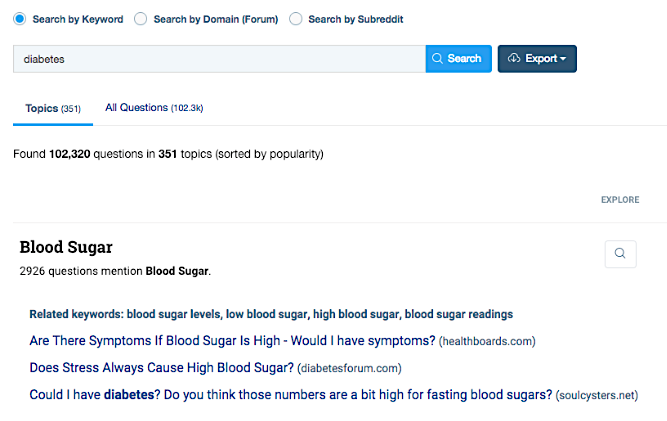
The beauty of this tool is that it won’t limit itself to your core term. Instead, it will use semantic analysis to find related words and discussions around them.
Learn More:
- 9 Effective SEO Techniques to Drive Organic Traffic
- What Is the Difference Between SEM and SEO?
- What Are the Biggest Website Mistakes that Are Lowering My SEO Ranking?
6) Listen to Your Customers
Listening to real people in your industry is the best source of inspiration.
The same applies for keyword research; nothing else will better arm your content marketing team than productive interactions with people who actually talk to their direct audience on a daily basis. Sales departments speak to customers day-in and day-out. They understand their pain points, goals and challenges more than anyone else, and answer lots of questions on a daily basis.
Here’s how you can listen to your customers and generate keyword ideas at the same time:
a) Get Ideas from Your Sales Team Using Your CRM
Go straight to the source and ask your sales team to list the common pain points, challenges and objections your typical customer has. Regardless of the questions being asked, make sure they’re all recorded properly and passed on to your content team, to be addressed through the content being published on your website.
The best part? Your sales team may not even need separate software to record those questions. Many project management platforms like Asana, Teamwork and Wrike already have note-taking spaces for sales reps to drop questions that content marketers can view.
b) Create Simple Customer Surveys
Different words mean different things to different people. For example: You might interpret the word “pound” as a type of cake. But to me, it represents a form of currency.
Seed Keywords is a simple tool that lets you find related keywords with help from your followers, and highlight what people interpret that word to mean. Just create a search scenario and ask your followers and friends to type in the keywords they’d use to solve it.
Try not to be too leading with your search scenario. Ask open-ended questions and don’t guide people to the search phrase you think they should be explaining.
Here’s an example of a scenario:

And here are the suggestions from real people:
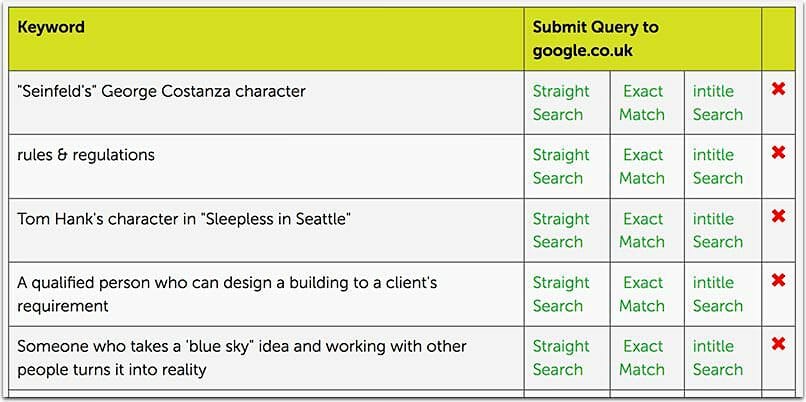
You can create similar surveys with SurveyMonkey or Google Forms, too, though you’ll have to manually send the survey to your network with the latter.
7) Insider Data from Google Analytics
Keyword research for SEO is an ongoing process. You can come up with a list of quality keywords when you first launch your website, but there are likely tons of related phrases you never would have considered in the first place.
That’s where Google Search Console comes in.
You can use the data collected about site visitors to determine which keywords people are searching for to find your website. This could uncover a sub-niche you hadn’t previously considered, as well as help you determine which subsets of keyword phrases are most valuable for you to pursue.
To find specific keyword data for your website:
- Open up your Google Search Console account
- Click your Performance report
- Select the Average Position filter
- Scroll down to find a list of keywords you’re ranking for, alongside their average position

Take a good look at the data and highlight the search phrases you’d like to increase ranking positions for.
- Do you see a keyword phrase that’s been used multiple times to access your website? They often just take a little re-optimization before climbing higher in the SERPs. You can also perform additional SEO keyword research on that specific phrase to uncover more opportunities within your niche.
- Do you see a number of similar keyword phrases you haven’t targeted heavily? If so, you may want to create a new page or post on your website revolving around these terms.
In a nutshell: Performing good SEO keyword research isn’t always fun, but it’s well worth the time invested when achieving strong SERP rankings and sending a steady stream of targeted traffic to your website.
Customers find a solution to problem, and you boost credibility by providing them with the answer. It’s a win-win situation all round!
How to Create a Keyword-Focused Content Strategy
With so many sources to find keywords, there’s a good chance you’ll quickly get overwhelmed. But the good thing is that keywords don’t only inspire; they help you get your entire content marketing strategy organized.
The first step is to identify keywords with “informational” search intent. People searching for them don’t intend to buy just yet, but they’re interested in learning more and researching further. AKA, they’re lingering in the top of the marketing funnel:
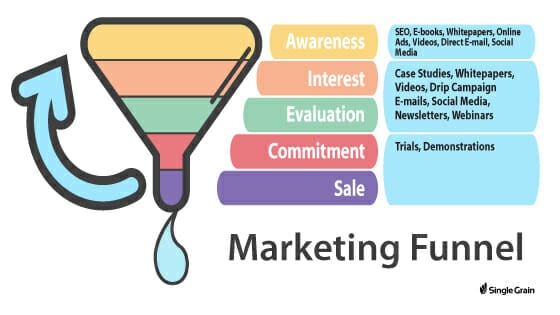
Unfortunately, there’s no golden tool to determine search intent. It takes common sense. For example: People searching for “healthy snacks recipe” are probably not looking to buy anything yet. Instead, they need a recipe to cook at home.
Ann Smarty, founder of MyBlogU, built a multi-level keyword organization strategy to overcome this:
Step 1: Identifying High-Level Content Structure
She says that usually, she organizes her keyword lists the following way:
- Core terms (i.e. competitive, generic keywords): Categories and content sections
- Modified keywords: Ideas for articles, lists, FAQ sections, product reviews, etc.
- Modifying the modifier: Some keywords are so specific that they will only work as part of a larger article (a subsection)
Step 2: Identifying Content Types
Use your best judgment to organize keywords by which type of content you think will fit best:
- Blog posts: These are usually filled with the most specific keywords.
- FAQ pages: If your brand page is in the query, you may want to create a new section in your frequently asked questions to address it.
- On-site glossaries: If it looks like a user needs a simple explanation of the term.
- Various types of cornerstone content (i.e. “content upgrades”): If you feel like there’s a lot to say about the search term, you may want to create a huge PDF guide or an infographic to give your customers something to download and take home.
Step 3: Identifying Seasonal Content
Again, your common sense will help you find keywords that should be implemented by a certain date. For example, “halloween snacks” is a pretty straightforward keyword showing you that related content should be published at least a week prior to the holiday.
Google Trends can also help you prepare your editorial calendar to publish new articles right in time for holidays and seasonal trends (back to school, national holidays, etc.):
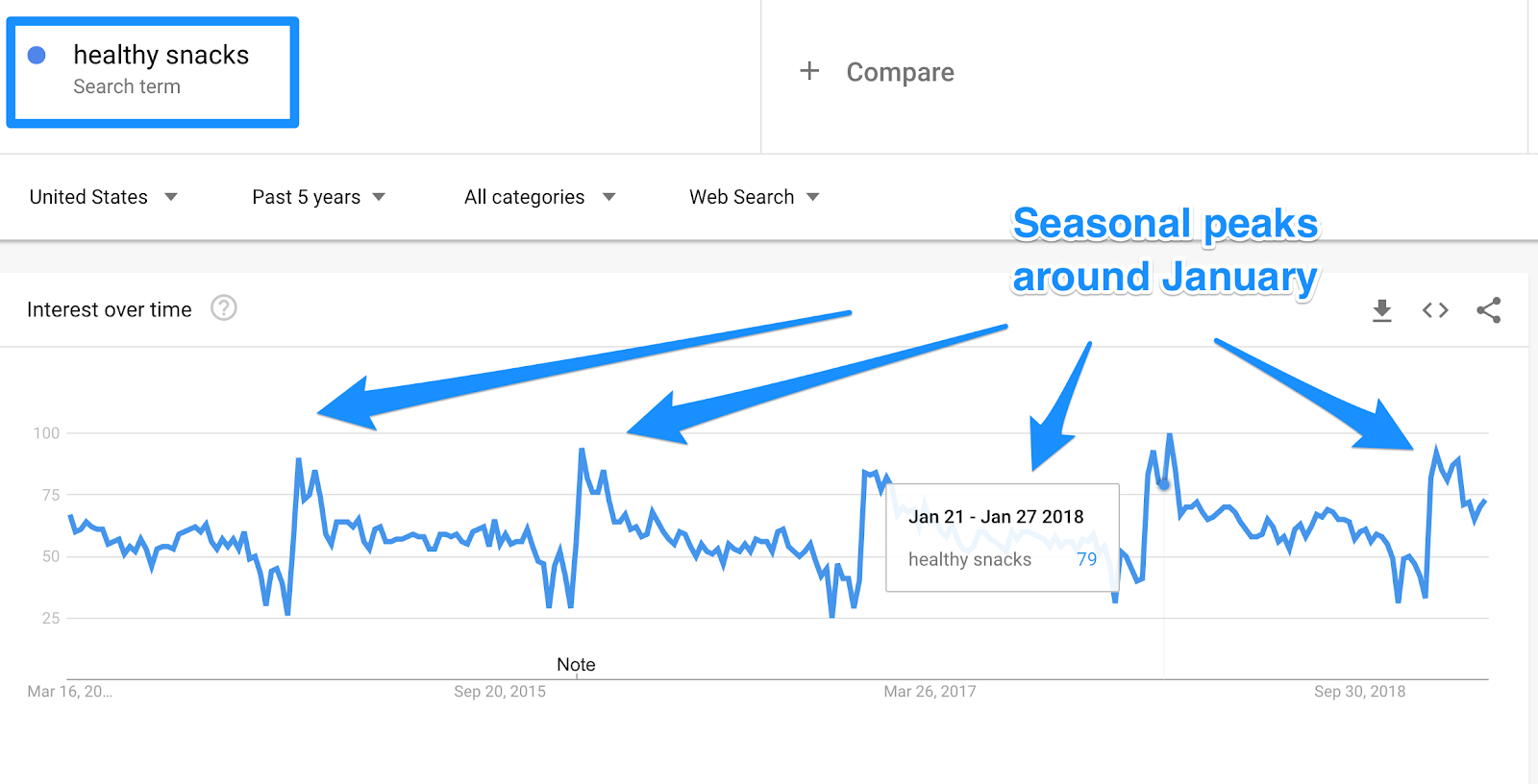
Step 4: Identifying the Required Action
Some keywords are action items for creating new content; some keywords may be used to optimize or update old articles.
Here’s what using keyword research to organize your content marketing strategy might look like in the end:

How to Optimize Your Content for SEO Keywords
What I’m about to say might come as a shock: Forget about keyword density, and forget about keyword tags. Both of them are outdated SEO concepts that won’t help you to rank in Google’s complex, ever-changing and often-confusing algorithm.
Why? Because they’re teetering on the brink of black hat SEO – a set of tactics that spammers previously used to “hack” their way to the top of the SERPs. But Google is smart, and black hat tactics don’t work anymore. (In fact, they have the opposite effect.) That doesn’t mean you should be wary of including your keyword on the page completely.
Your aim here is to create a piece of content that Google and readers will enjoy. That likely includes using the keywords you’ve found naturally throughout your writing. However, to communicate that your content is related to those search terms, use this keyword checklist for each piece of content you publish:
- Headline and meta title: Google picks this as the clickable link in a user’s search results, so including it in the title helps to boost organic click-through rate (a known ranking factor) because searchers know it’s relevant.
- URL structure: Which also shows up in search results and draws users’ eyes. Try to use the primary keyword as your URL title with dashes for spaces. For example: /blog/keyword-research-guide.
- First paragraph: This is what catches a reader’s eye first after the page headline. Give them a reason to spend more time on your website (another known ranking factor!).
- Subheadings: Hold the reader’s attention while they’re scrolling through your content. Google spiders also use heading tags to quickly understand what a page is discussing, so including keywords here could improve their rankings.
- Image alt text: Google aren’t smart enough to understand images… Yet. Help them out by naming your images with your keyword before uploading them, and setting the alt text as the primary phrase. This can also help you to rank in Image search.

Learn More:
- Getting Started with SEO: A Guide for Small Businesses
- Overlooked SEO: Optimizing Images and Video For Search
- 9 SEO Areas to Focus On to Boost Your Video’s Visibility
3 Action Steps for Creating an SEO-Boosting Content Plan
By this point, you’ve created a piece of content that’s optimized for a handful of keywords. What happens next?
Spoiler alert: The answer isn’t “sit back and wait for Google to rank me”. You’ll need to constantly work on your content to reach the top spots in your target audience’s SERPs.
Toggl put this to the test when they create their infographic, an image that visualized the different software development methods in a lighthearted way:

Within the first four days, the infographic brought in 56,000 visits (excluding all repeat visits and bot traffic) – and with only one unpaid Facebook post, a single Google+ share, and a couple of Tweets.
And, to their surprise, the infographic page quickly ranked at number five in Google search results for the term “software development” – an extremely competitive keyword.
Here’s what they learned throughout the process:
1) Don’t Underestimate the Power of Social
There are over 200 factors Google considers when ranking URLs. And while social media traffic is one of them, it’s hardly considered the most important signal. Google has directly said that social shares don’t impact rankings:
But that doesn’t mean they’re totally useless when attempting to rank your content higher in search.
Here’s why: When people like something, they’re likely to share it with others. Not only does this drive more traffic to your site, but it can also make more people post your content on other sites, resulting in valuable backlinks.
Toggl say their infographic ranked so well because of this:
“Our infographic has managed only a dozen backlinks (none particularly high in authority) and retains a high bounce rate (upwards of 90%). Neither of these is what SEOs would describe as “great.” At the same time, the high number of people who visit the the page spend an average of nearly 5 minutes on it.
In the interest of fairness, I should add that Toggl also has a high overall domain authority – another important ranking signal in Google’s eyes. Still, getting the infographic to rank well without a significant number of high-authority backlinks goes to show that with enough sharing, search engines take notice.”
So, how do you get enough shares?
2) Make It Viral
According to Toggl’s Mart Virkus: “As naïve as this advice sounds, making something viral isn’t as difficult as people make it out to be. Keep in mind that virality doesn’t need to mean international news coverage. Creating buzz in a specific community may just be enough.”
He recommends “thinking about a specific audience also helps you be more creative with your ideas. It’s much more fruitful to think about what a group of people would find interesting than about how to make an arbitrary viral ‘thing.’”
As we’ve previously pointed out:
“Marketers who are sending advertising messages into the void without knowing your exact wants, needs, preferences and experiences must use vague language in their ads in the hopes of connecting with at least a few of their messages’ recipients.
That is…unless they take advantage of buyer personas.”

Buyer personas are complete documents that detail every shared trait, behavior, interest, challenge and pain points that your audience share.
Mart says their “infographic worked because our service has a lot of clients from web development agencies. Toggl also grew out of one such agency, so putting the experience into a captivating image wasn’t a huge challenge.”
3) For Serious Results, Take Content Seriously
From start to finish, Mart reports the entire infographic taking over 23 hours to create. (43 minutes and 9 seconds to complete, to be exact.)
But he doesn’t think this is a waste of time–nor that you should try to find shortcuts: “You might think you could do it faster and cheaper, but the problem is that you’d be thinking the same way as everybody else.” In an SEO world where Google wants to rank the best, most-unique content on the first page, it’s a great train of thought.
Use Mart’s advice to always create new, exciting content, just like we explained how competitors shouldn’t be copied throughout your keyword research attempts.
Granted, it takes more time. But it’s worth it when you’re rewarded with higher keyword rankings, as Mart has proven!
Final Thoughts on Keyword Research
There’s no doubting that keyword research is the most essential part of content marketing.
It helps content marketers on so many levels, from understanding your reader and brainstorming, to organizing and structuring your content. It’d be pointless to publish a single piece without knowing your audience want to consume it, first.
The same kind of thinking applies to blog posts, videos and all other forms of content. But whichever way you choose to do your keyword research, never drop it from your content marketing to-do list.







